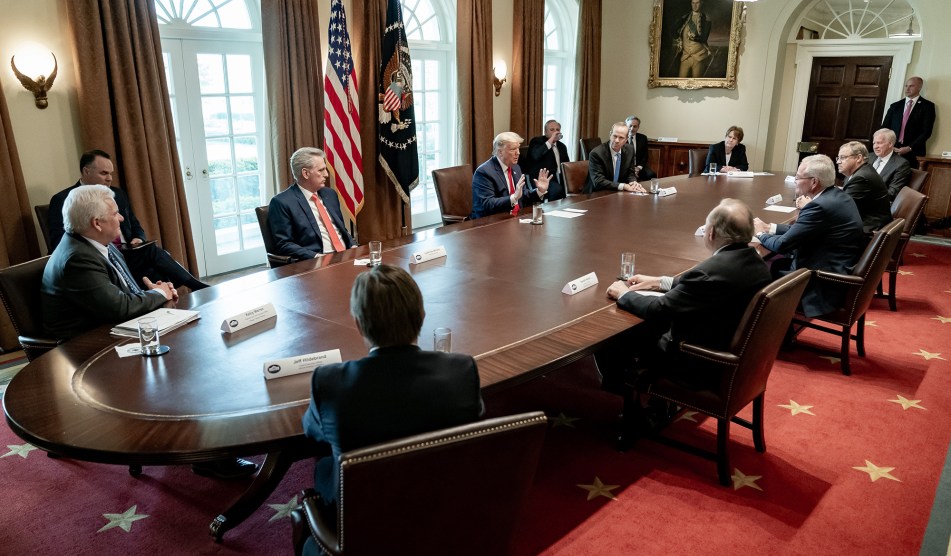
Who do you think Trump is talking to here? Yet another corporate roundtable? A group of his millionaire buddies? One thing you can be sure of is that he's not talking to either union leaders or people who make less than $50,000 per year. (Answer: it's a meeting with a bunch of corporate suits from the energy sector.)Shealah Craighead/White House/ZUMA
Donald Trump has bamboozled the working classes into thinking that he has their best interests at heart. He did this during the 2016 campaign mainly by appealing to immigration fears; bashing China; and disparaging liberal elites. The question in 2020 is whether the working classes still believe this.
Some do. Trump did, after all, work hard to keep out Central American immigrants. He did go toe-to-toe with China. And he’s certainly kept up the drumbeat against liberal elites. If this is enough for you, then you’ll remain a Trump fan.
But if you’re wondering whose interests he really considers important, all you have to do is look at his actions:
- Given a chance to intervene in oil prices, he chose to raise them. This was good for the oil industry but not so good for American gasoline purchasers.
- He tried to take away Obamacare without any kind of effective replacement. This would have reduced taxes on the affluent while denying the working classes one of their key sources of affordable health care.
- His tax cut in 2017 was almost entirely aimed at corporations and the rich. The rest of us got close to nothing.
- He promised he was the best thing ever for farmers, but his tariff war destroyed our agricultural markets in China.
- He is currently supporting a Republican war against the Post Office. This will probably help private package delivery services but hurt rural areas far more than urban areas.
- Manufacturing workers? When Trump took office they made up 8.5 percent of the workforce. Today they make up 8.4 percent and their hourly earnings have lagged the rest of the labor force. Meanwhile, corporate profits have jumped by 14 percent. That’s good for the rich but not so good for workers.
- In the coronavirus bill, he was concerned almost exclusively with bailing out businesses. His only sop to the working and middle classes was a one-time $1,200 check that his Treasury Secretary seemed to think would tide a family over for ten weeks. Meanwhile, it was up to Democrats to provide real assistance in the form of increased unemployment benefits, help for hospitals, and help for schools.
- Trump’s tariff war with China has cost middle-class families $500-1000 each. It’s not paid by China and it’s not a tax on corporations, who pass it along to consumers. It’s basically a tax on everyone who buys inexpensive things from overseas—which is mostly the middle class. The affluent escape most of the tax.
I understand entirely that rational arguments like this have only a limited effect in presidential elections. But surely they have some effect? There must be at least an appreciable chunk of the working and middle classes who are open to the argument that Trump has talked big but hasn’t really done much for them. When it comes to concrete campaign promises with a dollar sign in front of them, Trump has been great about keeping his promises to big business and the wealthy. It’s only his promises to the middle class that he’s broken.















